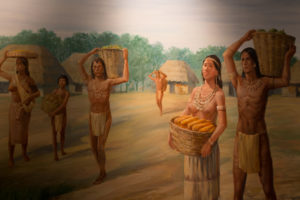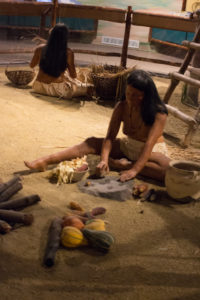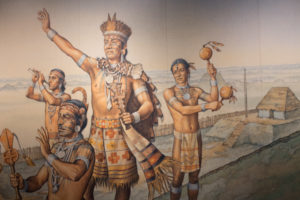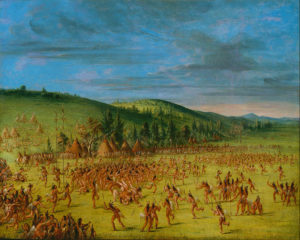The second most important celebration of the Natchez’ year was held through mid-September, or on the Moon of the Great Corn, the festivity that began the time of the harvest.
The Feast of the Grain it was called it times according to the French annalists, Du Pruts and Dumont, a celebration that was “… essentially eating in common and in a religious manner new corn which had been sown with this intention with suitable ceremonies …”
Greatly ahead of the time of the ceremony a new plot of land would be chosen, a patch of earth that had never been in the agricultural use before. Canes and creepers and vine stalks would be vigorously cut, the trees peeled off their bark up to the height of two feet, left there for fifteen days to rot then set on fire, after which only the green canes would remain in the bared field to be pulled out by the warriors. For only the warriors were to cultivate this special patch of land, the plot that would give the corn for the great Harvest Feast; they were the only ones allowed to sow the seed and to help it grow, so much so that if another person had came close to any stalk of the sacred field the touched maize with all its fruit would not be harvested when its time came but left to die in the field.
By the time the entire harvest was approaching maturity – the sacred plot of land as well as the rest of the fields – the warriors would go outside the village and select a clearing upon which the feast was to be held. Then they would go to work erecting a granary that would again serve to contain only the fruit of the sacred field. It was called momo-ataop which meant venerable granary.  Round in shape and raised more than two feet above the earth, it was furnished with cane mats inside, its bottom made of large whole canes and the outside walls provided with likewise protection against the sharp-teeth forest rodents. The whole clearing would be then tidied up for the ceremony, its grass cut kneel-high and its earth swept clean.
Round in shape and raised more than two feet above the earth, it was furnished with cane mats inside, its bottom made of large whole canes and the outside walls provided with likewise protection against the sharp-teeth forest rodents. The whole clearing would be then tidied up for the ceremony, its grass cut kneel-high and its earth swept clean.
By the time all was ready the corn would become ripe, and the same warriors responsible for the ceremony would harvest it and bring to the clearing in special cane baskets, hauling them up the ladders and emptying them into the granary in the ceremonial manner.
When it is done, the Great Sun is informed that all is ready and done, and so he determines the day when the Feast of Grain would be held and sends heralds to notify the people.
 On the day of the feast the entire nation pours out of their homes and toward the clearing at sunrise, each carrying utensils necessary of proper grain preparations. The main settlement drains off people quickly, and all that remains are the Great Sun himself and his most prominent and the oldest of warriors tasked with the duty of constructing a litter on which the great ruler would be carried all the way to the site of the ceremony. “… the litter is composed of four red bars which cross each other at the four corners of the seat … the entire seat is garnished inside with common deerskins, because it’s not seen … those which hang outside are painted with vivid designs of different colors … they conceal the seat so well that the substance of which it is composed cannot be seen … the back part of the seat is covered with leaves of tulip laurel … the outside border garnished with three strings of flowers … red poles are ornamented with white flowers …”
On the day of the feast the entire nation pours out of their homes and toward the clearing at sunrise, each carrying utensils necessary of proper grain preparations. The main settlement drains off people quickly, and all that remains are the Great Sun himself and his most prominent and the oldest of warriors tasked with the duty of constructing a litter on which the great ruler would be carried all the way to the site of the ceremony. “… the litter is composed of four red bars which cross each other at the four corners of the seat … the entire seat is garnished inside with common deerskins, because it’s not seen … those which hang outside are painted with vivid designs of different colors … they conceal the seat so well that the substance of which it is composed cannot be seen … the back part of the seat is covered with leaves of tulip laurel … the outside border garnished with three strings of flowers … red poles are ornamented with white flowers …”
The prominent warriors who prepare this means of conveyance then carry their ruler in turn, eight men at the time. In the meanwhile the clearing is busting with people ready to begin the festivities, appraised of the approach of their ruler by special cries of the advancing teams.
 Upon his arrival, the Great Sun would descend the litter in front of the sacred granary, uttering three traditional cries and being answered with nine likewise greetings from the surrounding crowds. At the ninth cry, the Great Sun would reach the throne, erected there beforehand, and the ceremony would be ready to begin when the war chief – the brother of the Sun and distinguished from the rest of the nobility by a diadem of white feathers – would stroll toward his august sibling to receive the sign. At this point, the Great Sun would rise again, turning to all four directions of the world, finishing with greeting the south where the granary stands and thus giving command to start doling out its sacred commodity.
Upon his arrival, the Great Sun would descend the litter in front of the sacred granary, uttering three traditional cries and being answered with nine likewise greetings from the surrounding crowds. At the ninth cry, the Great Sun would reach the throne, erected there beforehand, and the ceremony would be ready to begin when the war chief – the brother of the Sun and distinguished from the rest of the nobility by a diadem of white feathers – would stroll toward his august sibling to receive the sign. At this point, the Great Sun would rise again, turning to all four directions of the world, finishing with greeting the south where the granary stands and thus giving command to start doling out its sacred commodity.
The distinguished warriors then would climb the ladders of the granary, hauling out overloaded baskets, offering those to the female suns first – the Great Sun’s family members – and then to the rest of the women. Then most hectic activity ensues. Those who received the grain “… flee as though they had stolen it …”, hurrying to empty their treasures on the stretched skins they prepared beforehand and start the quick process of husking the corn and then grinding it in mortars, ready to be tossed into pots with water boiling on fires are boiling.
The warriors in the meanwhile would sing traditional songs, but when they see that the cooking is done, the designated speaker informs the master of the ceremony, who brings two plates to the throne of the Great Sun. The sovereign then would rise to accept the offering, presenting the dishes to all four direction again, then in his turn offering into the war chief, and this is the signal to begin the feast.
 The warriors ate first, then the boys of all ages except the nursing infants, then the women and girls. Intervals were inserted to allow more grain to be ground and cooked, because all the contents of the sacred granary has to be eaten through the two days of the festivities.
The warriors ate first, then the boys of all ages except the nursing infants, then the women and girls. Intervals were inserted to allow more grain to be ground and cooked, because all the contents of the sacred granary has to be eaten through the two days of the festivities.
Through the first interval, the warriors would split into two groups, place themselves at each side of the clearing and sing traditional warring songs. Then at the end, when everyone was replete, the war chief would stroll toward the pole erected through the morning preparations, to strike the blow to it and thus signal the beginning of speeches. From the Great Sun and the war chief himself down to every warriors and then the young men who never warred before, each would be given time to speak, to tell about his past warfare exploits or future intentions (in the case of the young men). It was imperative for every man aspiring to become someone of note to be able to express himself well in public, and so each speech was received with either traditional cries or lowered heads and silence of disapproval.
With the coming of night the clearing was lit with hundreds of torches, and the dancing would begin. The man with the water drum would place himself in the center of the circle around which women would organize themselves, moving with the beat of the drum, holding elegantly thin disks of feathers which they would turn left and right while dancing. Men with gourd rattles would enclose the dancing women in a wider circle, leaving them an ample space for movement, and while the women would turn from left to right, the men mirror their movement but in opposite direction. This went on until the dawn break, with each dancer living the circle when tiring or needing a break, reentering it whenever they are ready to dance again.
The next day the people would rest for a while, until the traditional ball game was commenced. For this, the warriors would divide themselves in two groups again, each distinguished by different insignia. One group was led by the Great Sun, the other by the war chief, a contest that lasted several hours, with the deerskin ball not allowed to touch the ground, attempted to be kept in the air and then move in the desired direction without being carried with the aid of every limb possible. The goal was to have the ball reaching either the throne of the Great Sun or the pole of the war chief.
It took considerable time to happen, but when it did, the losing side would present the winning one with a present and the honor to retain the mask of victory until the game of the next year’s ceremony was commenced. The spectacular war dance was to close the whole thing.
The rest of the second day was passed as the first, with another feast finishing the contents of the sacred granary, rounded up by speeches and dances. Then the Great Sun would being carried back to the village and the life would go back to normal, with the people attending their regular fields and the main harvest that was waiting to be picked and prepared for the winter.
Comments on Facebook
Comments
No Comments to “The Harvest Feast”